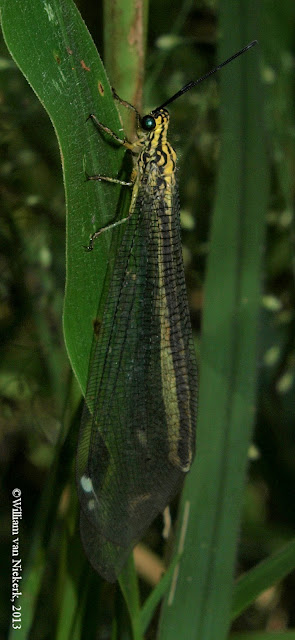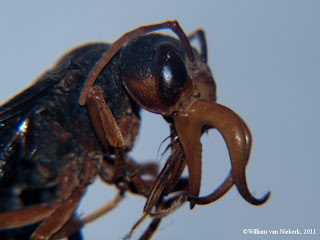You may - or may not, I suppose - notice that today's entry is missing the second part (specific epithet) of its 'binomial'. That's because, with my limited resources (A handful of outdated books and Google), it's very difficult to identify an awful lot of the world's wildlife with any real accuracy.
Let's start with what we have got.
We'll skip through
Eukaryota,
Animalia
and
Eumetazoa (still no sponges, so my apologies to any Poriferophiles), and into
Bilateralia (no corals, either... sad times),
Nephrozoa and get straight down to business in:
Protostomia - which, I would like to note, contains in addition to the dominant life-forms (in terms of ecological importance, diversity and sheer annual biomass) on earth, the vast majority of the diversity of land and the very first truly successful animal colonists of the land
. But that's not important, because we're now heading into
Ecdysozoa, and those earliest colonists are stuck over in its sister taxa,
Lophotrochozoa, where they have rasping tongues but do not (generally) shed their skins. Onwards to
Arthropoda, Phylum of the jointed exoskeleton, but arachnophobes need not fear because today we're heading into:
Hexapoda, which, for those of you whose Greek is letting them down, means "Six Footed". Which, as you may remember from primary school science classes, is a trait commonly associated with the
Insecta (or insects to their friends), which constitute well over half of the diversity of life on Earth. Who knew? Well, most people. At this point, some people like to note that everything alive on earth is full of nematodes, and so
Nematoda are really the dominant life form on the planet in simple terms of their ubiquity (and that really is a word), but in terms of amateur photography, most nematodes don't offer any exciting opportunities. So I'm going to stick with diversity, annual biomass and ecological significance.
Dicondylia is our next stopping point, where we say goodbye to the most ancestrally divergent insect group, the 'jumping bristletails' of
Archaeognatha (Not to be confused with the Bristletails of
Thysanura, which we now say goodbye to as we head into the
Pterygota, or winged insects. Fleas and lice, by the way, are counted within the
Pterygota because their ancestors had wings, but learned to live without them as they hopped and blood-sucked their way through life.
Metapterygota excludes a handful of primitive flying insects, most notable of which are probably the mayflies in
Ephemeroptera, which are unique amongst winged insects for many reasons, not least that they are the only insect to shed their skin while possessing usable wings (all other insects have their final shed at metamorphosis, and never grow or, in any real term, heal after that. Be nice to insects. They're fragile.
Neoptera excludes another, but radically different, group of primitive flying insects, the dragonflies. Unlike the
Ephemeroptera, which take to the air for a few hours to weeks to mate and breed before starving to death (they physically cannot feed as adults), the
Odonata take to the wing after months to years as the minute masters of the pond and become, on their scale, masters of the skies. Their scale is a little less impressive now than it once was, as in the relative low oxygen of our modern atmosphere, even the largest tropical species cannot grow beyond a twenty centimetre wingspan, and don't reach a fraction of the weight of their crow-sized relatives of prehistory. But enough about them, because now we're heading into the
Polyneoptera, sometimes grouped with several unrelated clades in the
Exopterygota (literally "outside wings", referring to the external development of wings through the nymphal stages of development), but incomplete metamorphosis seems to be an ancestral state, so I'm sticking with
Polyneoptera for now. But the contentiousness continues, as we take another step into:
Dictyoptera, which is either a superorder or an order, depending on your preferences, and unites, essentially, three orders of cockroaches. Blattophobes beware.
Fortunately for said Blattophobes, cockroach is here used in its very broadest sense, to encompass the three (rather disparate) groups of cockroaches which are often given separate orders of their own; the cockroaches as traditionally defined in
Blattodea, which are commonly held to be the ancestral group from which the colonial, herbivorous cockroaches in
Isoptera (otherwise known as termites)
sprang, and (probably) also the parent group to the solitary, predatory third order of, admittedly not-very-cockroachy after all insects in the:
Mantodea, which you might guess comprises the animals commonly known as Mantises. As far as insect orders go, it's not all that huge (2400-odd species), which is part of the reason that it's not been consistently divided into superfamilies just yet. The vast majority of its species are within the (possibly over-assigned) family
Mantidae, but we're heading into the much smaller:
Sybillidae, which has three genera and a mere sixteen described species. That should make things easy but, turns out, it doesn't. I'm going to venture (at this point - and I hope to be able to commit further at a later date) is that our current subject is in the only subfamily:
Sibyllinae, and the only tribe:
Sibyllini, and the largest of the three genera:
Sibylla (Sibylla) pretiosa
Stal, 1856
[UPDATED 28-03-2014 - a lot of what follows was written before the specimen was narrowed down to a species, in March 2014]
So, before you notice that I'm not even committing to a subgenus, let's meet the lovely
Sibyl...la.
If anyone feels like pointing out that it is a dead ringer for the one reasonably well known species of the family (Sibylla (Sibylla) pretiosa), I'll be obliged to counterpoint that in fact, the trade in exotic insects as pets is not known for its attention to taxonomy. So I am waiting for the Bulletin du Museum National d'Histoire Naturelle, Section A: Zoologie, Biologie et Ecologie Animales to become available online, specifically part one of their 1996 issue, and then I may have more to tell you...
This nymph - and its teddy-bear head ornament - was one of dozens seen on walls, branches and occasionally rocks around Chongwe, Lusaka Province, Zambia in September 2011, and could be trusted to eat as many of the endless mosquitoes as they got their jagged little claws into. By late October, adults had begun to appear, which added to the suspicion that this is not S. pretiosa, which is often touted as having green wings;
Whereas this individual - and its compatriots - sported dead-leaf pink instead.
BUT [update 28/03/2014]
When this was originally written, I had not yet managed to find the Mantodea species file - a fantastic resource approaching openly-available information from the same angle as the oft-cited
Orthoptera species file, although as yet in the significantly younger stages of its development.
While not as user-friendly as its parent project, it nevertheless indicates that of all the various species of Sibylla, only one extends down into our area of interest, and that is Sibylla pretiosa. While I didn't completely rule out that species based on the green-ness of wings, I am going to remind myself and anyone who reads this that a single colour character really is not a valid species dismissal tool - because, pink though the adults of the ploughing rains were, by December-January, most of them looked more like this:
.JPG) |
| Photographed in Chongwe, December 2013, using Olympus E-420 DSLR, Zuiko 40-150mm and 3 KOOD magnifiers. |
Note the green wings.
So, yes,
Sibylla pretiosa, and the rest of it is now update to reflect this.

b.JPG)
.JPG)

.JPG)
.JPG)
.JPG)

.JPG)
.JPG)
.JPG)

.JPG)
.JPG)
.JPG)
.JPG)
.JPG)
.JPG)